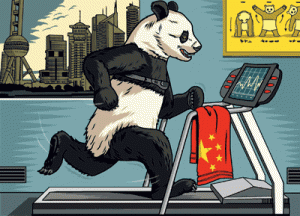Game theory & China’s underlying problem
The economic growth in China has been dramatic in the last few decades. For ten consecutive years from 2003 – 2012, China maintained its annual growth in real GDP above 10%. The way it grows, however, poses a question of moral hazards that can cause an inevitable economic “hard-landing” if not properly dealt with.
Local governments’ over-spending via state-controlled enterprises are so prevalent (main source) such that “blind investment in some industries and low-efficiency, redundant construction haven’t been effectively arrested.” This ignorance obviously led to problems as the source says, “if overall fixed-asset investment in China grows at last year’s 27 percent pace, domestic capital spending will account for half of China’s gross domestic product in 2004. That’s too high an investment ratio because it’s leading to shortages of everything from raw materials to electricity.”
While many may ask, “why can’t put a stop to it?” The answer is not clear immediately. In the main source, economists use moral hazard as a general description, to link the problem to an ill-conceived incentive. Using what we learned from the class, we can analyze the phenomenon formally in game theory.
The major players in the economic growth are state-owned enterprises that make up a large part of China’s economy. Take for example Company A and Company B; for them, the payoff matrix of spending in a specific industry is:
This looks much like two companies trying to enter the same market. We assume the market here is civil engineering, which includes projects like industrial parks, transportation, and where only state-owned enterprises can spend their huge budget. We also know that the central government, Beijing, does not strictly regulate these state-owned enterprises as long as they boost China’s economy growth. That is, earning maximum profit is put on a secondary place. In fact, government spending is an important component of GDP, not profits of any kind. From an enterprise’s view, the growth also matters because it attracts other investors to invest in the company, while their gains and losses are backed up by Beijing’s tremendous money reserve.
The payoffs therefore are measured by growth (instead of profit). If only one company decides to enter, then it contributes to the growth by 100, while the other does nothing. If both enter, then they both contribute by 100. The dominant strategy for both Company A and B is not surprisingly, to spend.
However, since capital spending by local authorities all comes from the central bank, and the bank is generous in giving loans to them, the lack of regulations contributes to the “moral hazard.” The payoff to spend money, even to waste money, is dominant strategy for state-owned enterprises. No judgment is made on how they effectively use the money from Beijing. An ill-conceived incentive is thus created.
The dominant strategy is optimal for each individual companies, but a significant danger for Beijing. “When party officials can’t produce growth (even with virtually free capital), they invent it,” says the source. Therefore, if the situation lasts, it will likely sabotage the entire Chinese economy along with the normal life of every taxpayer. The solution may be tightening up the regulations (penalties for over-spending), or to encourage one company’s growth in another, yet emerging industry.
Of course, there are many factors to consider to judge a country’s economic growth, but a complete rundown will be surplus for the purpose of my discussion. This article serves to analyse where game theory can be applied to economic problems—most surprisingly—how a game between two players (or more) can “snowball” into a mess for even the most robust economy.
Sources:
http://www.bloomberg.com/apps/news?pid=newsarchive&sid=a5.c9TS3HN40 – main
http://en.wikipedia.org/wiki/Gross_domestic_product
http://en.wikipedia.org/wiki/Economy_of_China
Topic of interest:
How would you act?


